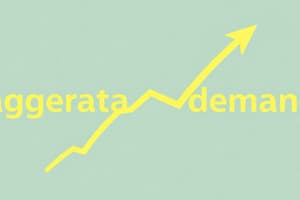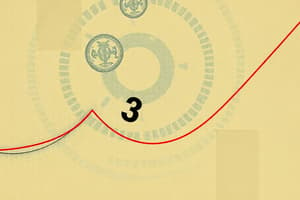Podcast
Questions and Answers
What does the short-run equilibrium condition AD = SRAS imply about the economy?
What does the short-run equilibrium condition AD = SRAS imply about the economy?
- The economy is producing above its potential GDP.
- Planned expenditures are aligned with production plans. (correct)
- There is a surplus of goods in the market.
- Inflation rates are at their highest point.
What happens at the intersection of short-run aggregate supply and aggregate demand curves?
What happens at the intersection of short-run aggregate supply and aggregate demand curves?
- Inflation is expected to rise indefinitely.
- Equilibrium price level is established. (correct)
- A natural increase in output is guaranteed.
- Market imbalance occurs.
If the economy is experiencing short-run equilibrium and there is a decrease in aggregate demand, what is the expected outcome?
If the economy is experiencing short-run equilibrium and there is a decrease in aggregate demand, what is the expected outcome?
- Unemployment will significantly decrease.
- Both production and prices will rise.
- There will be no impact on production levels.
- Firms will reduce production and prices. (correct)
What characterizes long-run equilibrium in the AD-AS model?
What characterizes long-run equilibrium in the AD-AS model?
What does a price adjustment imply in the context of aggregate demand and short-run aggregate supply?
What does a price adjustment imply in the context of aggregate demand and short-run aggregate supply?
If the economy is initially at long-run equilibrium but then faces a negative macroeconomic shock, what outcome might occur?
If the economy is initially at long-run equilibrium but then faces a negative macroeconomic shock, what outcome might occur?
In the context of the AD-AS model, what is a key difference between short-run and long-run aggregate supply?
In the context of the AD-AS model, what is a key difference between short-run and long-run aggregate supply?
What can be inferred from a sustained increase in the productive capacity of the economy by 1 - 2% per year?
What can be inferred from a sustained increase in the productive capacity of the economy by 1 - 2% per year?
What is the implication of firms cutting production in the short run?
What is the implication of firms cutting production in the short run?
What effect does a positive shock to Aggregate Demand (AD) typically have on the economy in the short run?
What effect does a positive shock to Aggregate Demand (AD) typically have on the economy in the short run?
What is indicated by the vertical Long-run Aggregate Supply (LRAS) curve?
What is indicated by the vertical Long-run Aggregate Supply (LRAS) curve?
Which scenario is an example of a negative shock to Aggregate Demand?
Which scenario is an example of a negative shock to Aggregate Demand?
Which result follows a contraction in Aggregate Demand in the short run?
Which result follows a contraction in Aggregate Demand in the short run?
What is a common economic effect of an overheating economy due to increased AD?
What is a common economic effect of an overheating economy due to increased AD?
During a period of economic recession caused by a negative shock to AD, what happens to the equilibrium output?
During a period of economic recession caused by a negative shock to AD, what happens to the equilibrium output?
What does a decrease in Aggregate Demand typically cause in terms of price levels?
What does a decrease in Aggregate Demand typically cause in terms of price levels?
What economic condition is often illustrated by the aggregate supply curve shifting to the left?
What economic condition is often illustrated by the aggregate supply curve shifting to the left?
What term is used to describe a period of contracting real GDP and rising unemployment?
What term is used to describe a period of contracting real GDP and rising unemployment?
How is long-run real GDP primarily determined?
How is long-run real GDP primarily determined?
Which of the following accurately describes the aggregate demand curve?
Which of the following accurately describes the aggregate demand curve?
What significant economic event occurred that interrupted 15 years of consistent GDP growth in Canada?
What significant economic event occurred that interrupted 15 years of consistent GDP growth in Canada?
What is a depression considered in economic terms?
What is a depression considered in economic terms?
Which of the following statements about unemployment during economic downturns is true?
Which of the following statements about unemployment during economic downturns is true?
What does the aggregate supply curve represent in relation to price levels?
What does the aggregate supply curve represent in relation to price levels?
What does the term 'economic shocks' refer to?
What does the term 'economic shocks' refer to?
What is the likely outcome if the aggregate demand decreases?
What is the likely outcome if the aggregate demand decreases?
In the short-run, what primarily influences fluctuations in equilibrium real GDP?
In the short-run, what primarily influences fluctuations in equilibrium real GDP?
Flashcards
Productive capacity expansion
Productive capacity expansion
The economy's ability to produce goods and services grows by 1-2% annually.
Short-Run Equilibrium
Short-Run Equilibrium
The point where Aggregate Demand (AD) equals Short-Run Aggregate Supply (SRAS), meaning planned spending matches firms' production plans.
Aggregate Demand (AD)
Aggregate Demand (AD)
The total planned spending by consumers, investors, and others in the economy.
Short-Run Aggregate Supply (SRAS)
Short-Run Aggregate Supply (SRAS)
Signup and view all the flashcards
Price Level
Price Level
Signup and view all the flashcards
Real GDP
Real GDP
Signup and view all the flashcards
Long-Run Equilibrium
Long-Run Equilibrium
Signup and view all the flashcards
Potential GDP
Potential GDP
Signup and view all the flashcards
Natural Rate of Output
Natural Rate of Output
Signup and view all the flashcards
Macroeconomic shocks
Macroeconomic shocks
Signup and view all the flashcards
AD Shock
AD Shock
Signup and view all the flashcards
AS Shock
AS Shock
Signup and view all the flashcards
Positive AD Shock
Positive AD Shock
Signup and view all the flashcards
Negative AD Shock
Negative AD Shock
Signup and view all the flashcards
LRAS Curve
LRAS Curve
Signup and view all the flashcards
Recession
Recession
Signup and view all the flashcards
Aggregate Demand
Aggregate Demand
Signup and view all the flashcards
Aggregate Supply
Aggregate Supply
Signup and view all the flashcards
Economic Fluctuations
Economic Fluctuations
Signup and view all the flashcards
Business Cycle
Business Cycle
Signup and view all the flashcards
Equilibrium Real GDP
Equilibrium Real GDP
Signup and view all the flashcards
AD-AS Model
AD-AS Model
Signup and view all the flashcards
Long-run Real GDP
Long-run Real GDP
Signup and view all the flashcards
Aggregate Expenditure
Aggregate Expenditure
Signup and view all the flashcards
Study Notes
Chapter 14: Aggregate Demand and Aggregate Supply
- This chapter examines the market for goods and services
- Real GDP fluctuates, usually growing but often unevenly
- Recessions occasionally occur
- The AD-AS model is used to determine equilibrium real GDP and explain its fluctuations, mainly focusing on short-to-medium-term fluctuations
- Real GDP has ups and downs, following a business cycle
- The business cycle is not regular, unlike seasonal patterns
- Canada experienced about 15 consecutive years of growth in real GDP before 2008
- Growth resumed in 2009, but at a slower pace
- The pandemic significantly impacted growth
- A recession is characterized by contracting real GDP and rising unemployment
- A depression is a severe recession
Economic Fluctuations
- Economic fluctuations are irregular and unpredictable
- Real GDP and investment spending are not consistently positive and have ups and downs
- Unemployment rises significantly when real GDP falls, even slightly
- Economic trends show strong positive correlation, even if the magnitude varies
- Economic data from 1870-2017 illustrate irregular fluctuations in real GDP
- Macroeconomic instability and unpredictability are crucial concepts to understand
Model of AD and AS
- The model explains short-run fluctuations in equilibrium real GDP
- Long-run real GDP is determined by input levels and productivity, discussed in previous chapters
- The model focuses on short-run variations around the longer-term trend in real GDP
AD Curve
- The AD curve illustrates the relationship between the overall price level and real GDP
- The relationship has a negative slope
- Three main reasons for the negative slope are the wealth effect, the real exchange rate effect, and the interest rate effect
- Shifts in the AD curve are caused by factors other than price, impacting expenditure levels
- Increases in expenditure (e.g., investment, net exports, government spending, consumption) cause the AD curve to shift to the right
- Decreases in expenditure cause the AD curve to shift to the left
Aggregate Supply
- Aggregate Supply (AS) has two components: short-run and long-run
- The short-run AS curve slopes upward
- The long-run AS curve is vertical
- The long-run aggregate supply (LRAS) level is determined by factors influencing production potential (land, labor, capital, and technology) and is not affected by the price level
Shifts in AS Curve
- Factors impacting productivity or costs, not the price level, shift the short-run aggregate supply (SRAS) curve
- Increases in productivity or decreases in costs shift SRAS to the right
- Decreases in productivity or increases in costs shift SRAS to the left
- Any change in the price level moves along the AD or AS curve
Shifts in LRAS curve
- Factors like technological advancements, production capacity, human capital, labor force, and natural resources impact the long-run aggregate supply (LRAS) curve
- An increase in these factors shifts the LRAS curve to the right.
- A decrease in these factors shifts the LRAS curve to the left.
Applications of AD-AS Model
- The model helps analyze macroeconomic shocks, especially AD and AS shocks, which are shifts in the respective curves
- Positive and negative shocks to AD or AS cause shifts, and the model predicts impacts on equilibrium output and price levels
Equilibrium Analysis
- Equilibrium occurs when planned expenditure matches production plans, with the price level adjusting to ensure consistency, similar to the microeconomic supply and demand model.
Studying That Suits You
Use AI to generate personalized quizzes and flashcards to suit your learning preferences.




